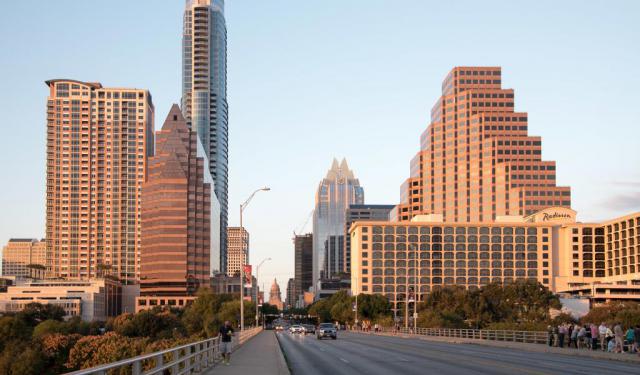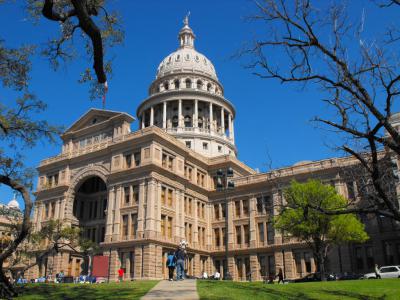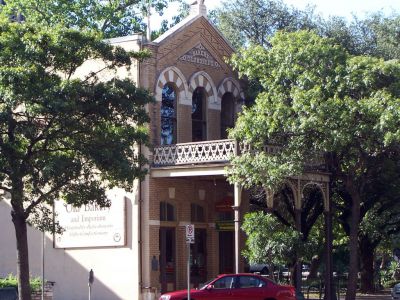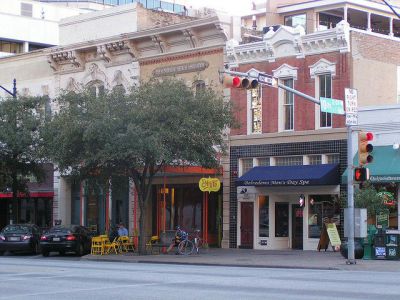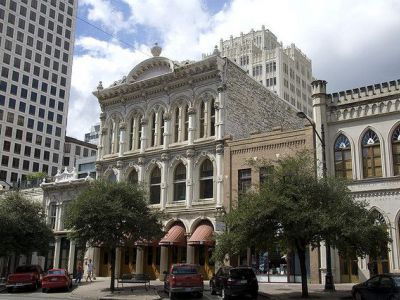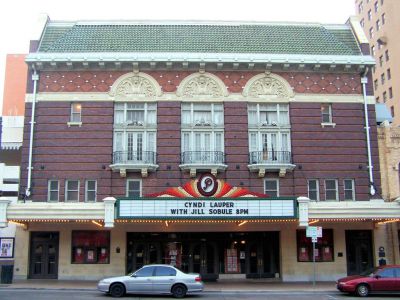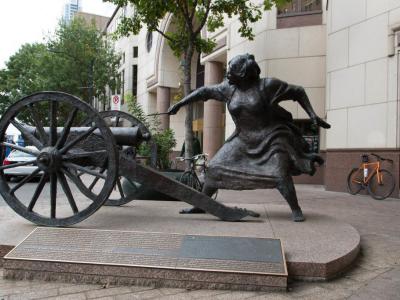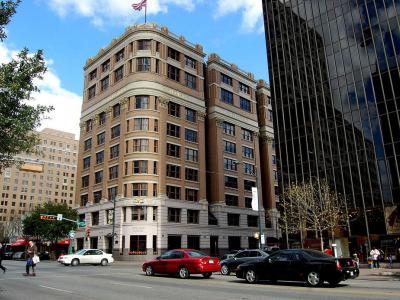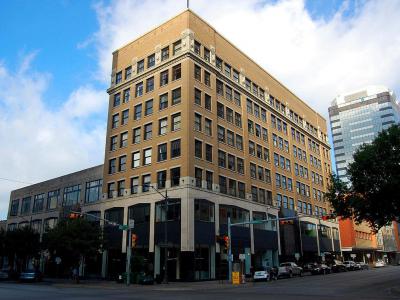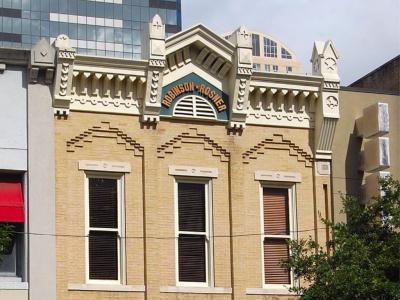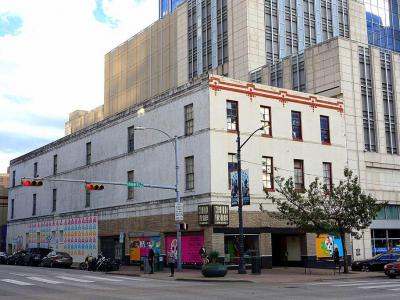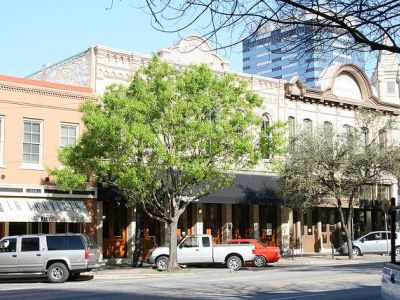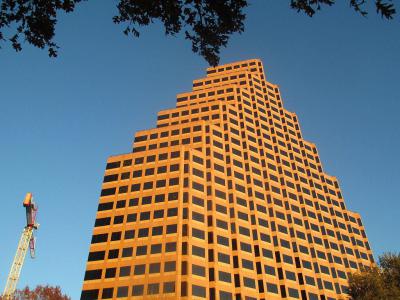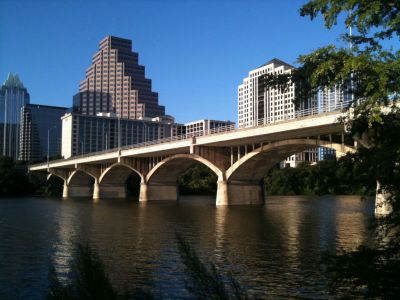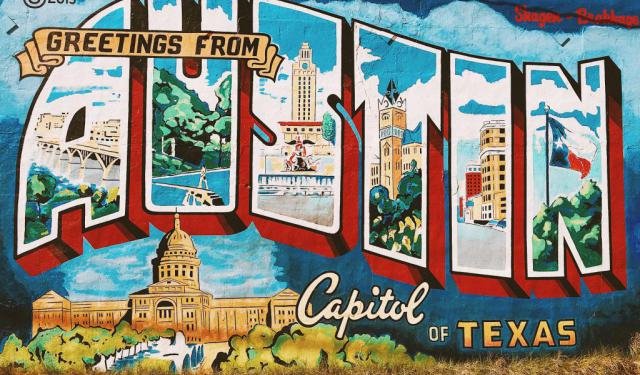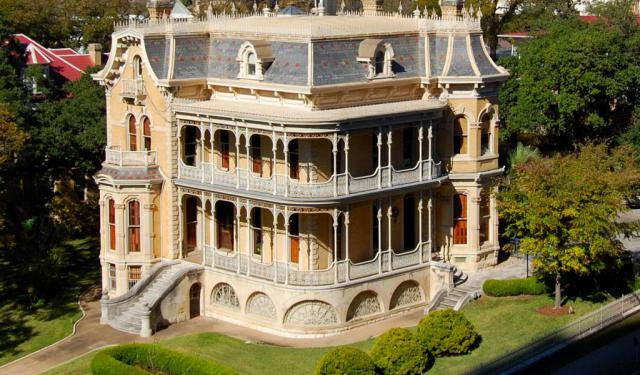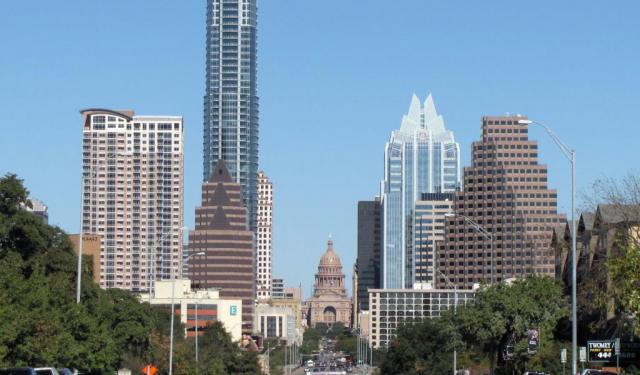Congress Avenue Walking Tour (Self Guided), Austin
Congress Avenue is the main street in Austin, Texas, and historically its first one. Since the city's establishment in the first half of the 19th century, it has evolved and today bears the mark of Austin’s economic and cultural development. Stretching approximately 1.5 miles, this iconic thoroughfare is a must-visit for tourists.
At the northern end of the avenue stands the majestic Texas State Capitol, a symbol of Texas' political power and history. As you make your way south, you'll encounter the Lundberg Bakery, which in the late 19th century was a staple for delicious baked goods, plus the Jacob Lamour Block, a historic building that adds character to the area.
Continuing southward, you'll come across the Walter Tips Building, an architectural gem with its unique charm, and the renowned Paramount Theatre, a cultural landmark that hosts a variety of live shows. Nearby, you can admire the Angelina Eberly Statue, commemorating a Texan heroine who played a significant role in preserving Austin as the state capital.
The Littlefield Building and the Scarborough Building add a touch of modernity, while the Robinson-Rosner Building graces the avenue with its historic architecture. Art enthusiasts will find the Mexic-Arte Museum a delightful location, showcasing vibrant Mexican and Mexican-American art.
Further along, the Koppel Building and Cooper's Old Time Pit Bar-B-Que offer a mix of history and flavors, with the latter being a perfect spot for a meal. One Congress Plaza provides a stunning view of the cityscape, and the Congress Avenue Bridge is famous for the spectacular bat flights that occur at dusk when thousands of Mexican free-tailed bats take to the sky.
Visiting Congress Avenue is a journey through history, culture, and culinary delights. With modern skyscrapers rubbing shoulders with the old two- and three-story buildings, it makes for an interesting sightseeing walk. So, wait no more. Come explore this iconic street in the heart of Texas' capital city and treat yourself to a truly wonderful experience.
At the northern end of the avenue stands the majestic Texas State Capitol, a symbol of Texas' political power and history. As you make your way south, you'll encounter the Lundberg Bakery, which in the late 19th century was a staple for delicious baked goods, plus the Jacob Lamour Block, a historic building that adds character to the area.
Continuing southward, you'll come across the Walter Tips Building, an architectural gem with its unique charm, and the renowned Paramount Theatre, a cultural landmark that hosts a variety of live shows. Nearby, you can admire the Angelina Eberly Statue, commemorating a Texan heroine who played a significant role in preserving Austin as the state capital.
The Littlefield Building and the Scarborough Building add a touch of modernity, while the Robinson-Rosner Building graces the avenue with its historic architecture. Art enthusiasts will find the Mexic-Arte Museum a delightful location, showcasing vibrant Mexican and Mexican-American art.
Further along, the Koppel Building and Cooper's Old Time Pit Bar-B-Que offer a mix of history and flavors, with the latter being a perfect spot for a meal. One Congress Plaza provides a stunning view of the cityscape, and the Congress Avenue Bridge is famous for the spectacular bat flights that occur at dusk when thousands of Mexican free-tailed bats take to the sky.
Visiting Congress Avenue is a journey through history, culture, and culinary delights. With modern skyscrapers rubbing shoulders with the old two- and three-story buildings, it makes for an interesting sightseeing walk. So, wait no more. Come explore this iconic street in the heart of Texas' capital city and treat yourself to a truly wonderful experience.
How it works: Download the app "GPSmyCity: Walks in 1K+ Cities" from Apple App Store or Google Play Store to your mobile phone or tablet. The app turns your mobile device into a personal tour guide and its built-in GPS navigation functions guide you from one tour stop to next. The app works offline, so no data plan is needed when traveling abroad.
Congress Avenue Walking Tour Map
Guide Name: Congress Avenue Walking Tour
Guide Location: USA » Austin (See other walking tours in Austin)
Guide Type: Self-guided Walking Tour (Sightseeing)
# of Attractions: 14
Tour Duration: 2 Hour(s)
Travel Distance: 1.5 Km or 0.9 Miles
Author: christine
Sight(s) Featured in This Guide:
Guide Location: USA » Austin (See other walking tours in Austin)
Guide Type: Self-guided Walking Tour (Sightseeing)
# of Attractions: 14
Tour Duration: 2 Hour(s)
Travel Distance: 1.5 Km or 0.9 Miles
Author: christine
Sight(s) Featured in This Guide:
- Texas State Capitol
- Lundberg Bakery
- Jacob Lamour Block
- Walter Tips Building
- Paramount Theatre
- Angelina Eberly Statue
- Littlefield Building
- Scarborough Building
- Robinson-Rosner Building
- Mexic-Arte Museum
- Koppel Building
- Cooper's Old Time Pit Bar-B-Que
- One Congress Plaza
- Congress Avenue Bridge /Austin Bats
1) Texas State Capitol (must see)
The Texas State Capitol, located in downtown Austin, is a significant historical and architectural landmark. It serves as the seat of government for the state of Texas, housing the offices and chambers of the Texas Legislature and the Governor of Texas. The Capitol was designed by architect Elijah E. Myers and constructed between 1882 and 1888 under the supervision of civil engineer Reuben Lindsay Walker. In 1970, it was added to the National Register of Historic Places, and in 1986, it was designated as a National Historic Landmark.
Architecturally, the Capitol is an exemplar of the Italian Renaissance Revival style. It is constructed primarily from limestone sourced from Pecan Point quarries and sandstone from nearby Barton Creek. Remarkably, the Texas State Capitol is 302.64 feet (92.24 meters) tall, making it the sixth-tallest state capitol and one of several taller than the United States Capitol in Washington, D.C.
The Texas State Capitol proudly stands on a hill, providing a picturesque view over downtown Austin. The building has undergone several modifications over the years, incorporating various additions, including a prominent dome that crowns a rotunda. This dome, designed by architect Elijah Ealy Clark, is a notable feature of the Capitol.
The rotunda showcases portraits of all individuals who have held the position of President in the Republic of Texas or served as Governor of the State of Texas. In the southern foyer, you can find sculptures of Sam Houston and Stephen F. Austin, which were created by Elisabeth Ney. Interestingly, the rotunda also functions as a whispering gallery.
The Capitol itself is quite spacious, spanning 360,000 square feet (33,000 square meters), which is more extensive than any other state capitol building in the country. It sits on a land area of 2.25 acres and boasts nearly 400 rooms along with over 900 windows.
Strategically positioned, the Texas State Capitol demarcates the State Capitol Mall from downtown Austin. Open to the public, it stands as a testament to the state's history, especially its construction during an economic downturn caused by an agricultural depression. The Capitol's construction was funded through state bonds instead of taxes.
Architecturally, the Capitol is an exemplar of the Italian Renaissance Revival style. It is constructed primarily from limestone sourced from Pecan Point quarries and sandstone from nearby Barton Creek. Remarkably, the Texas State Capitol is 302.64 feet (92.24 meters) tall, making it the sixth-tallest state capitol and one of several taller than the United States Capitol in Washington, D.C.
The Texas State Capitol proudly stands on a hill, providing a picturesque view over downtown Austin. The building has undergone several modifications over the years, incorporating various additions, including a prominent dome that crowns a rotunda. This dome, designed by architect Elijah Ealy Clark, is a notable feature of the Capitol.
The rotunda showcases portraits of all individuals who have held the position of President in the Republic of Texas or served as Governor of the State of Texas. In the southern foyer, you can find sculptures of Sam Houston and Stephen F. Austin, which were created by Elisabeth Ney. Interestingly, the rotunda also functions as a whispering gallery.
The Capitol itself is quite spacious, spanning 360,000 square feet (33,000 square meters), which is more extensive than any other state capitol building in the country. It sits on a land area of 2.25 acres and boasts nearly 400 rooms along with over 900 windows.
Strategically positioned, the Texas State Capitol demarcates the State Capitol Mall from downtown Austin. Open to the public, it stands as a testament to the state's history, especially its construction during an economic downturn caused by an agricultural depression. The Capitol's construction was funded through state bonds instead of taxes.
2) Lundberg Bakery
The Lundberg Bakery, also known as the Old Bakery and Emporium, is a historic site located in downtown Austin, which currently functions as a gift shop. This building was completed in the year 1876. During the early days of the bakery's operation, bread was not packaged or wrapped for sale. Instead, customers would wait in line with baskets lined with cloth to carry their freshly purchased bread.
The bakery continued its operation until its owner, Charles Lundberg, a Swedish immigrant, passed away in 1895. Subsequently, the building changed ownership multiple times until it was acquired and renovated by the Austin Heritage Society in 1962. In 1970, the bakery faced a threat of demolition when plans were made to construct a new building for the Texas Department of Transportation. Fortunately, its preservation was ensured when excavations next door revealed the foundations of the previous state capitol building. These foundations were then transformed into a historical plaza, and the bakery was spared.
Constructed primarily from limestone with a brick facade, the building boasts a prominent cast-iron eagle at the apex of its gabled roof, which overlooks Congress Avenue. Notably, it was added to the National Register of Historic Places on December 17, 1969.
The bakery continued its operation until its owner, Charles Lundberg, a Swedish immigrant, passed away in 1895. Subsequently, the building changed ownership multiple times until it was acquired and renovated by the Austin Heritage Society in 1962. In 1970, the bakery faced a threat of demolition when plans were made to construct a new building for the Texas Department of Transportation. Fortunately, its preservation was ensured when excavations next door revealed the foundations of the previous state capitol building. These foundations were then transformed into a historical plaza, and the bakery was spared.
Constructed primarily from limestone with a brick facade, the building boasts a prominent cast-iron eagle at the apex of its gabled roof, which overlooks Congress Avenue. Notably, it was added to the National Register of Historic Places on December 17, 1969.
3) Jacob Lamour Block
The Jacob Lamour Block in Austin stands as a testament to the design talents of Jacob Lamour, a prominent architect in nineteenth-century Texas. Established in 1876, this row of two-story commercial buildings is located in the heart of downtown Austin and showcases the unique Italianate features that were popular in that era.
Jacob Lamour, the architect behind these buildings, moved to Austin in 1871, at a time when the city was experiencing rapid growth due to its designation as the permanent state capital a year prior. The end of Reconstruction in 1872 marked a new wave of investments in the city, both from public and private sectors. Lamour played a significant role in shaping Austin's built environment during this period of expansion and transformation.
His influence in the construction industry was profound, with his offices producing more than fifty documented buildings across Texas. These structures ranged from public and commercial to residential buildings, each reflecting the high-style architectural elements characteristic of the time. Notably, Lamour was the only architect listed in the first Austin City Directory (1872–73), highlighting his significance in the city's architectural scene.
The Jacob Lamour Block, specifically, stands out for its Italianate facades, each distinct yet harmoniously integrated with its neighbors. Despite being built in the 19th century, these buildings have maintained their charm and functionality, continuing to serve as commercial spaces for stores and cafes. Their enduring use and appeal underscore Lamour's architectural prowess.
Jacob Lamour, the architect behind these buildings, moved to Austin in 1871, at a time when the city was experiencing rapid growth due to its designation as the permanent state capital a year prior. The end of Reconstruction in 1872 marked a new wave of investments in the city, both from public and private sectors. Lamour played a significant role in shaping Austin's built environment during this period of expansion and transformation.
His influence in the construction industry was profound, with his offices producing more than fifty documented buildings across Texas. These structures ranged from public and commercial to residential buildings, each reflecting the high-style architectural elements characteristic of the time. Notably, Lamour was the only architect listed in the first Austin City Directory (1872–73), highlighting his significance in the city's architectural scene.
The Jacob Lamour Block, specifically, stands out for its Italianate facades, each distinct yet harmoniously integrated with its neighbors. Despite being built in the 19th century, these buildings have maintained their charm and functionality, continuing to serve as commercial spaces for stores and cafes. Their enduring use and appeal underscore Lamour's architectural prowess.
4) Walter Tips Building
The Walter Tips Building is one of the most beautiful pieces of architecture to be found on Austin's Congress Avenue. Built in 1876, this three-story stone building masterfully blends Venetian Gothic and Italianate Renaissance Revival styles, and is one of several properties constructed by architect Jasper Newton Preston for the Tips Foundry & Machine Company. The eastern facade on the second and third floors bear prominent Venetian Gothic features, with a row of five richly decorated bay windows framed by fluted and banded pilasters with Corinthian and foliated capitals.
On the inside, large open spaces have been maintained by means of a cast-iron colonnade spanned by cast-iron arches running the length of the building down the center at the first level and by a similar colonnade of wood members at the second level. The construction has two skylights. The Tips Building is a City of Austin Landmark and a contributing building to the National Register-listed Congress Avenue Historic District.
Today, it is still used as a commercial space.
On the inside, large open spaces have been maintained by means of a cast-iron colonnade spanned by cast-iron arches running the length of the building down the center at the first level and by a similar colonnade of wood members at the second level. The construction has two skylights. The Tips Building is a City of Austin Landmark and a contributing building to the National Register-listed Congress Avenue Historic District.
Today, it is still used as a commercial space.
5) Paramount Theatre
The Paramount Theatre, situated in downtown Austin, is a historic venue that serves as both a live theater and cinema. Constructed in the Classical Revival architectural style in 1915, this establishment has a rich and lengthy history spanning over a century. During its existence, the Paramount has hosted a diverse range of performances, from vaudeville acts to the premieres of numerous films, including both silent movies and "talkies." Some notable film premieres at the theater include Batman in 1966 and Sin City in 2005, in addition to various music, dance, and Broadway productions.
Over the years, a plethora of legendary artists and performers have graced the Paramount's stage, including renowned figures like Houdini, the Marx Brothers, Helen Hayes, Orson Welles, Sarah Bernhardt, the Ziegfeld Follies, the Metropolitan Opera, Lillian Russell, and George M. Cohan. More contemporary favorites who have performed here include Billy Joel, Willie Nelson, Jerry Jeff Walker, Sarah Vaughan, and Mandy Patinkin.
In recognition of its historical significance, the Paramount Theatre was officially added to the National Register of Historic Places on June 23, 1976.
Over the years, a plethora of legendary artists and performers have graced the Paramount's stage, including renowned figures like Houdini, the Marx Brothers, Helen Hayes, Orson Welles, Sarah Bernhardt, the Ziegfeld Follies, the Metropolitan Opera, Lillian Russell, and George M. Cohan. More contemporary favorites who have performed here include Billy Joel, Willie Nelson, Jerry Jeff Walker, Sarah Vaughan, and Mandy Patinkin.
In recognition of its historical significance, the Paramount Theatre was officially added to the National Register of Historic Places on June 23, 1976.
6) Angelina Eberly Statue
Angelina Belle Peyton Eberly, born on July 2, 1798, and passing away on August 15, 1860, was not only an innkeeper but also a significant figure in the history of Austin, particularly during the Texas Archive War. In 1836, she married Captain Jacob Eberly, who was a widower at the time. Together, they relocated to Austin in 1839, where they established the Eberly House, an inn or tavern.
On October 18, 1839, President Mirabeau B. Lamar and his cabinet had a meal at her establishment instead of the official presidential residence. Later, when Sam Houston succeeded Lamar, he chose to reside at the Eberly House, further highlighting its importance.
In December 1842, Sam Houston decided to secretly relocate the government archives of the Republic to the safety of Washington-on-the-Brazos. Mrs. Eberly realized that this meant the removal of vital symbols of the national government from Austin. In response, she fired a six-pound cannon into the General Land Office Building, which caught the attention of the townsfolk, who saw it as an act of theft. This event sparked what is now known as the Archive War. Ultimately, the Austinites emerged victorious in this conflict, ensuring that Austin remained the capital of Texas and the guardian of the state's archives.
Today, a bronze statue of Angelina Eberly, created by Pat Oliphant, stands near the location where she played a pivotal role in preserving Austin as the capital city of Texas.
On October 18, 1839, President Mirabeau B. Lamar and his cabinet had a meal at her establishment instead of the official presidential residence. Later, when Sam Houston succeeded Lamar, he chose to reside at the Eberly House, further highlighting its importance.
In December 1842, Sam Houston decided to secretly relocate the government archives of the Republic to the safety of Washington-on-the-Brazos. Mrs. Eberly realized that this meant the removal of vital symbols of the national government from Austin. In response, she fired a six-pound cannon into the General Land Office Building, which caught the attention of the townsfolk, who saw it as an act of theft. This event sparked what is now known as the Archive War. Ultimately, the Austinites emerged victorious in this conflict, ensuring that Austin remained the capital of Texas and the guardian of the state's archives.
Today, a bronze statue of Angelina Eberly, created by Pat Oliphant, stands near the location where she played a pivotal role in preserving Austin as the capital city of Texas.
7) Littlefield Building
The Littlefield Building in Austin is a historical and architectural landmark. This nine-story building, which was completed in 1912, holds the distinction of being Austin's first office building and was the tallest commercial building in the city for nearly twenty years, reaching a height of 140 feet.
The building is named after George Washington Littlefield, a prominent Texan cattle baron and banker. Littlefield initially established his American National Bank in 1890 at the nearby Driskill Hotel before constructing the Littlefield Building twenty years later. The building's design follows the Beaux Arts style, which gracefully combines 20th-century steel construction with classical ornamentation.
The building's interior and exterior reflect its rich history. While the interior has lost some of its historic elements, it once boasted bronze doors from Tiffany & Co. and a bank lobby adorned with large oil paintings depicting ranch life, the source of Littlefield's wealth. Furthermore, an intricately carved mahogany women's banking center, a pioneering feature in the city at the time, was part of the interior design.
The exterior of the Littlefield Building is a testament to the Beaux Arts style, particularly evident in its classical elements such as the Corinthian columns made of brick that span five stories. These decorative features contrast with the modern construction methods used, similar to those employed in the nearby 515 Congress building. The design choices of the Littlefield Building reflect an architectural era where the expression of modern structural techniques was gaining prominence, aligning with the emerging modernism style in Europe.
The building is named after George Washington Littlefield, a prominent Texan cattle baron and banker. Littlefield initially established his American National Bank in 1890 at the nearby Driskill Hotel before constructing the Littlefield Building twenty years later. The building's design follows the Beaux Arts style, which gracefully combines 20th-century steel construction with classical ornamentation.
The building's interior and exterior reflect its rich history. While the interior has lost some of its historic elements, it once boasted bronze doors from Tiffany & Co. and a bank lobby adorned with large oil paintings depicting ranch life, the source of Littlefield's wealth. Furthermore, an intricately carved mahogany women's banking center, a pioneering feature in the city at the time, was part of the interior design.
The exterior of the Littlefield Building is a testament to the Beaux Arts style, particularly evident in its classical elements such as the Corinthian columns made of brick that span five stories. These decorative features contrast with the modern construction methods used, similar to those employed in the nearby 515 Congress building. The design choices of the Littlefield Building reflect an architectural era where the expression of modern structural techniques was gaining prominence, aligning with the emerging modernism style in Europe.
8) Scarborough Building
The Scarbrough Building in Austin stands as a symbol of the city's architectural and commercial evolution. Completed in 1910, this 110-foot, 8-story edifice initially held the title of the tallest private building in Texas, marking Austin's entry into the era of "skyscrapers." It was named after the Scarbrough's department store, a regional retail giant, which originally occupied the building.
Situated at the intersection of Congress Avenue and Sixth Street, the Scarbrough Building enjoys a prime location in the heart of Austin. This intersection has long been considered the city's symbolic center. The building's prominence was briefly challenged when George Littlefield, a local businessman, expanded his nearby building to surpass its height.
The brainchild of Emerson Monroe Scarbrough, an Alabama native, the building is a prime example of the Chicago Style of architecture. This style is recognized for its use of masonry cladding (brick, stone, or terra cotta) over a steel frame and features a tripartite design reminiscent of a classical column: a sturdy base, a plain middle, and a decorative top. The Scarbrough Building's construction was a significant event in Austin, with its innovative concrete-and-steel structure being the subject of much local speculation and betting.
However, by the late 20th century, the Scarbrough department store, like many downtown retailers, succumbed to the growing popularity of suburban shopping malls, leading to its closure in 1982. Following a period of varied tenancy, the building has found new life. Its ground floor and basement now host a bustling social club, while the upper floors are occupied by a diverse mix of offices and tech startups. In 1931, the building's lower floors were remodeled in the Art Deco style, reflecting a modernization trend of the era and adding to the building's architectural significance.
Situated at the intersection of Congress Avenue and Sixth Street, the Scarbrough Building enjoys a prime location in the heart of Austin. This intersection has long been considered the city's symbolic center. The building's prominence was briefly challenged when George Littlefield, a local businessman, expanded his nearby building to surpass its height.
The brainchild of Emerson Monroe Scarbrough, an Alabama native, the building is a prime example of the Chicago Style of architecture. This style is recognized for its use of masonry cladding (brick, stone, or terra cotta) over a steel frame and features a tripartite design reminiscent of a classical column: a sturdy base, a plain middle, and a decorative top. The Scarbrough Building's construction was a significant event in Austin, with its innovative concrete-and-steel structure being the subject of much local speculation and betting.
However, by the late 20th century, the Scarbrough department store, like many downtown retailers, succumbed to the growing popularity of suburban shopping malls, leading to its closure in 1982. Following a period of varied tenancy, the building has found new life. Its ground floor and basement now host a bustling social club, while the upper floors are occupied by a diverse mix of offices and tech startups. In 1931, the building's lower floors were remodeled in the Art Deco style, reflecting a modernization trend of the era and adding to the building's architectural significance.
9) Robinson-Rosner Building
The Robinson-Rosner Building, located on Congress Avenue in the heart of downtown Austin, is renowned as the oldest documented structure on this prominent street. This building has a rich history that dates back to 1854, marking it as an essential piece of Austin's architectural and cultural heritage.
Initially constructed as a plain stone commercial building, the Robinson-Rosner Building was originally designed to house a bakery and a dry goods store, reflecting the commercial needs of the time. The building's structure is primarily composed of limestone and brick, materials typical of the period and indicative of the building techniques used in the mid-19th century.
One of the most distinctive features of the Robinson-Rosner Building is its Gothic Revival architectural style, particularly evident in its facade. This Victorian facade, which was added in the 1880s, significantly enhanced the building's aesthetic appeal and architectural significance. The Gothic Revival style is characterized by its intricate designs and ornamental elements, which are prominently displayed on the building's exterior.
A notable feature of the facade is the engraving of the "Robinson-Rosner" name, a tribute to the building's historical significance and its original proprietors. This engraving not only adds to the building's charm but also serves as a reminder of its historical roots and the legacy of its founders.
Today, the Robinson-Rosner Building stands as a proud symbol of Austin's history, embodying the architectural trends and commercial history of the mid-19th century. Its preservation and restoration efforts highlight the city's commitment to maintaining its historical landmarks, making the Robinson-Rosner Building a must-see destination for those interested in architecture, history, and the evolution of urban landscapes.
Initially constructed as a plain stone commercial building, the Robinson-Rosner Building was originally designed to house a bakery and a dry goods store, reflecting the commercial needs of the time. The building's structure is primarily composed of limestone and brick, materials typical of the period and indicative of the building techniques used in the mid-19th century.
One of the most distinctive features of the Robinson-Rosner Building is its Gothic Revival architectural style, particularly evident in its facade. This Victorian facade, which was added in the 1880s, significantly enhanced the building's aesthetic appeal and architectural significance. The Gothic Revival style is characterized by its intricate designs and ornamental elements, which are prominently displayed on the building's exterior.
A notable feature of the facade is the engraving of the "Robinson-Rosner" name, a tribute to the building's historical significance and its original proprietors. This engraving not only adds to the building's charm but also serves as a reminder of its historical roots and the legacy of its founders.
Today, the Robinson-Rosner Building stands as a proud symbol of Austin's history, embodying the architectural trends and commercial history of the mid-19th century. Its preservation and restoration efforts highlight the city's commitment to maintaining its historical landmarks, making the Robinson-Rosner Building a must-see destination for those interested in architecture, history, and the evolution of urban landscapes.
10) Mexic-Arte Museum
The Mexic-Arte Museum, established in 1984 in Austin, is dedicated to showcasing and preserving the richness of Mexican, Latino, and Latin American art and culture. Founded by artists Sylvia Orozco, Sam Coronado, and Pio Pulido, the museum emerged from a profound need to create a space celebrating Mexican art and culture, which was significantly underrepresented at the time. Situated in the Arts Warehouse in downtown Austin, it has since grown into a vital hub for cultural education and appreciation, serving over 75,000 visitors annually, more than half of whom are people of color.
Central to the museum's mission is its commitment to community-centered programming, offering visitors an immersive cultural learning experience. The museum's permanent collection boasts over 5,000 historical and contemporary works, featuring significant collections such as The Serie Print Project Archive, the Ernesto F. de Soto Collection, the Juan Sandoval Jr. Collection, the Taller Grafica Popular Print Collection, Popular Mexican Dance Masks, and a rare book collection in the Mexic-Arte Museum Library.
Education is a cornerstone of the Mexic-Arte Museum's philosophy. Through its exhibitions and special programs, the museum has reached over 200,000 underserved Austin youth with innovative art education initiatives like the Screen It! and AmArte programs. The Mexic-Arte Museum continues to be a beacon in Texas, striving to improve the quality of life through its groundbreaking exhibitions and educational programming, emphasizing diversity, cross-cultural understanding, and the celebration of Mexican American heritage in central Texas.
Central to the museum's mission is its commitment to community-centered programming, offering visitors an immersive cultural learning experience. The museum's permanent collection boasts over 5,000 historical and contemporary works, featuring significant collections such as The Serie Print Project Archive, the Ernesto F. de Soto Collection, the Juan Sandoval Jr. Collection, the Taller Grafica Popular Print Collection, Popular Mexican Dance Masks, and a rare book collection in the Mexic-Arte Museum Library.
Education is a cornerstone of the Mexic-Arte Museum's philosophy. Through its exhibitions and special programs, the museum has reached over 200,000 underserved Austin youth with innovative art education initiatives like the Screen It! and AmArte programs. The Mexic-Arte Museum continues to be a beacon in Texas, striving to improve the quality of life through its groundbreaking exhibitions and educational programming, emphasizing diversity, cross-cultural understanding, and the celebration of Mexican American heritage in central Texas.
11) Koppel Building
The Koppel Building in Austin is a historical edifice with a rich past, constructed in 1888. Designed by B. McDonald, it was built for William Radam, a Prussian immigrant. Remarkably, this two-story building has endured the passage of time with minimal changes from its original structure. Throughout its history, it has been utilized for various purposes, including a hotel, a store, and even a brothel. In recent times, it serves as the premises for Joseph A Bank Clothiers.
Architecturally, the Koppel Building is an impressive example of the Victorian Gothic Revival style. One of its most striking features is the intricately detailed pressed metal cornice. The facade of the building is divided into distinct bays by brick pilasters, and floral medallions beautifully accentuate the vertical and horizontal intersections. Constructed predominantly of brick, the building showcases occasional corbelling, which lends a sense of depth and complexity to the facade's planes.
The windows of the Koppel Building are arched and make a bold architectural statement. Originally, a corner pavilion supported a tower, but both these elements have since been removed, leaving a chamfered and somewhat stark corner. Over the years, there have been some alterations, particularly at the storefront at ground level, which have slightly diminished the building's historical authenticity. Despite these changes, the Koppel Building remains a significant and evocative piece of Austin's architectural heritage.
Architecturally, the Koppel Building is an impressive example of the Victorian Gothic Revival style. One of its most striking features is the intricately detailed pressed metal cornice. The facade of the building is divided into distinct bays by brick pilasters, and floral medallions beautifully accentuate the vertical and horizontal intersections. Constructed predominantly of brick, the building showcases occasional corbelling, which lends a sense of depth and complexity to the facade's planes.
The windows of the Koppel Building are arched and make a bold architectural statement. Originally, a corner pavilion supported a tower, but both these elements have since been removed, leaving a chamfered and somewhat stark corner. Over the years, there have been some alterations, particularly at the storefront at ground level, which have slightly diminished the building's historical authenticity. Despite these changes, the Koppel Building remains a significant and evocative piece of Austin's architectural heritage.
12) Cooper's Old Time Pit Bar-B-Que
Cooper's Old Time Pit Bar-B-Que restaurant, honored to be the "Best Of The Best" in the barbecue business, known for its two-inch-thick pork "Big Chop" much as for being former US President George W. Bush's favorite barbecue joint, celebrated the history of Congress Avenue in the early 20th century by setting themselves up in a historic building on Congress.
Over the years, the 200 block of Congress has been the home to several pubs, saloons, cafes and restaurants. Now it has been brought back to life thanks to renovation. Back in the day, across the street was home to the International and Great Northern Rail Road Depot, built in 1888. And the upstairs space at 217 was once the Travis Hotel, rumored to have been a cat house!
Cooper's Old Time Pit Bar-B-Que is part of the Cooper family's restaurant legacy that dates back to the 1950s. At Cooper's, you can enjoy a variety of smoked meats such as brisket, ribs, sausage, chicken, and cabrito. However, what sets Cooper's apart is its famous "Big Chop," a thick two-inch pork chop. The meats are smoked in large rectangular pits, using fast-burning mesquite wood to infuse a subtle smoky flavor, different from the slow-smoked barbecue style.
One unique feature of Cooper's is their barbecue sauce, which is served on the side. It's a special concoction made by smoking a mix of ingredients, including ketchup, vinegar, black pepper, Louisiana hot sauce, lard, and brisket drippings. This sauce adds an extra layer of flavor to the delicious smoked meats they offer.
Cooper's Old Time Pit Bar-B-Que in Austin is more than just a restaurant; it is a vibrant fusion of culinary excellence, historical significance, and a testament to family tradition in the heart of Texas.
Over the years, the 200 block of Congress has been the home to several pubs, saloons, cafes and restaurants. Now it has been brought back to life thanks to renovation. Back in the day, across the street was home to the International and Great Northern Rail Road Depot, built in 1888. And the upstairs space at 217 was once the Travis Hotel, rumored to have been a cat house!
Cooper's Old Time Pit Bar-B-Que is part of the Cooper family's restaurant legacy that dates back to the 1950s. At Cooper's, you can enjoy a variety of smoked meats such as brisket, ribs, sausage, chicken, and cabrito. However, what sets Cooper's apart is its famous "Big Chop," a thick two-inch pork chop. The meats are smoked in large rectangular pits, using fast-burning mesquite wood to infuse a subtle smoky flavor, different from the slow-smoked barbecue style.
One unique feature of Cooper's is their barbecue sauce, which is served on the side. It's a special concoction made by smoking a mix of ingredients, including ketchup, vinegar, black pepper, Louisiana hot sauce, lard, and brisket drippings. This sauce adds an extra layer of flavor to the delicious smoked meats they offer.
Cooper's Old Time Pit Bar-B-Que in Austin is more than just a restaurant; it is a vibrant fusion of culinary excellence, historical significance, and a testament to family tradition in the heart of Texas.
13) One Congress Plaza
One Eleven Congress, formerly known as One Congress Plaza, is a notable skyscraper located in the heart of Downtown Austin. This architectural landmark stands at a height of 397 feet (121 meters) and features 30 floors, ranking it as the 17th tallest building in the city. The structure is not only a part of Austin's skyline but also a testament to the city's growth, having been constructed in 1987 during Austin's boom in the 1970s and 1980s.
The building is distinguished by its unique design elements. It was designed by architect Victor A. Lundy, with interior design by Susman Tisdale Gayle Architects. The exterior of One Eleven Congress is striking, with a facade of red granite and bronze-tinted glass. Its step-like pyramid shape is a distinct feature, with the tops of each step illuminated by blue neon lighting, adding a vibrant touch to Austin's nighttime skyline. The lobby is equally impressive, adorned with a ceiling of patterned Burmese teak.
One Eleven Congress is not just a place of business but also a hub for communal activities. It features a sunken plaza that includes trees, a food hall, water features, and park benches. This plaza serves as a venue for the AMOA Art Show, blending urban architecture with cultural events.
One Eleven Congress is recognized as one of Austin's waterfront skyscrapers, adding to its allure and significance in the city's landscape.
The building is distinguished by its unique design elements. It was designed by architect Victor A. Lundy, with interior design by Susman Tisdale Gayle Architects. The exterior of One Eleven Congress is striking, with a facade of red granite and bronze-tinted glass. Its step-like pyramid shape is a distinct feature, with the tops of each step illuminated by blue neon lighting, adding a vibrant touch to Austin's nighttime skyline. The lobby is equally impressive, adorned with a ceiling of patterned Burmese teak.
One Eleven Congress is not just a place of business but also a hub for communal activities. It features a sunken plaza that includes trees, a food hall, water features, and park benches. This plaza serves as a venue for the AMOA Art Show, blending urban architecture with cultural events.
One Eleven Congress is recognized as one of Austin's waterfront skyscrapers, adding to its allure and significance in the city's landscape.
14) Congress Avenue Bridge /Austin Bats (must see)
The Ann W. Richards Congress Avenue Bridge, previously known as the Congress Avenue Bridge, is situated over Lady Bird Lake in Austin. Prior to the completion of the Longhorn Dam in 1960, this bridge spanned the Colorado River, which is now impounded as Lady Bird Lake. It had been named the Congress Avenue Bridge since its initial construction in the late 19th century until November 16, 2006, when the Austin City Council decided to rename it in honor of Ann W. Richards. She served as the 45th Governor of Texas and was a long-time resident of Austin.
This bridge is made of concrete and features three southbound and three northbound vehicle lanes, with sidewalks on both sides. The Ann W. Richards Congress Avenue Bridge is renowned for housing the world's largest urban bat colony, consisting of Mexican free-tailed bats. These bats live beneath the road deck in gaps between the concrete components. They are migratory, spending their summers in Austin and their winters in Mexico.
Every evening at dusk, the bats emerge from beneath the bridge and fly across Lady Bird Lake, primarily to the east, in search of food. This spectacle attracts up to 100,000 tourists annually. Visitors can observe the bats from the bridge itself, from the riverbanks, and even from boats. Interestingly, the Austin Ice Bats, a minor-league hockey team, took its name from the bridge's famous bat colony. Additionally, the song "Bats" by Kimya Dawson and rapper Aesop Rock was inspired by the immense number of bats residing under this bridge.
This bridge is made of concrete and features three southbound and three northbound vehicle lanes, with sidewalks on both sides. The Ann W. Richards Congress Avenue Bridge is renowned for housing the world's largest urban bat colony, consisting of Mexican free-tailed bats. These bats live beneath the road deck in gaps between the concrete components. They are migratory, spending their summers in Austin and their winters in Mexico.
Every evening at dusk, the bats emerge from beneath the bridge and fly across Lady Bird Lake, primarily to the east, in search of food. This spectacle attracts up to 100,000 tourists annually. Visitors can observe the bats from the bridge itself, from the riverbanks, and even from boats. Interestingly, the Austin Ice Bats, a minor-league hockey team, took its name from the bridge's famous bat colony. Additionally, the song "Bats" by Kimya Dawson and rapper Aesop Rock was inspired by the immense number of bats residing under this bridge.
Walking Tours in Austin, Texas
Create Your Own Walk in Austin
Creating your own self-guided walk in Austin is easy and fun. Choose the city attractions that you want to see and a walk route map will be created just for you. You can even set your hotel as the start point of the walk.
Austin Street Art Walk
Austin, Texas may be famed as the “Live Music Capital of the World,” but its street art is just as vibrant, funky, and diverse as its plentiful music venues. Indeed, Texas’s capital is practically peppered with dozens of murals, sometimes in the most unexpected places.
Among the artworks gracing the city's walls there are some truly iconic pieces that illustrate the kinky side of... view more
Tour Duration: 2 Hour(s)
Travel Distance: 3.4 Km or 2.1 Miles
Among the artworks gracing the city's walls there are some truly iconic pieces that illustrate the kinky side of... view more
Tour Duration: 2 Hour(s)
Travel Distance: 3.4 Km or 2.1 Miles
Downtown Historical Buildings Walking Tour
Northwest downtown Austin boasts an impressive collection of historic residences of notable styles, ranging from classic Victorian to Georgian to Greek Revival. Carefully preserved and restored, these constructions – from nationally listed historic sites to the significant local elements of the built environment – form a major part of Austin’s cultural heritage and indelible chapter of its... view more
Tour Duration: 2 Hour(s)
Travel Distance: 3.4 Km or 2.1 Miles
Tour Duration: 2 Hour(s)
Travel Distance: 3.4 Km or 2.1 Miles
Austin Introduction Walking Tour
Despite the official status of Texas' capital, Austin never fails to surprise visitors with its unique artsy community and lively atmosphere. The city proudly wears the title of "The Live Music Capital of the World" thanks to the eclectic live-music scene centered around country, blues and rock, established since the 1970s by the likes of Willie Nelson, Asleep at the Wheel, and... view more
Tour Duration: 2 Hour(s)
Travel Distance: 3.7 Km or 2.3 Miles
Tour Duration: 2 Hour(s)
Travel Distance: 3.7 Km or 2.3 Miles
The Most Popular Cities
/ view all
